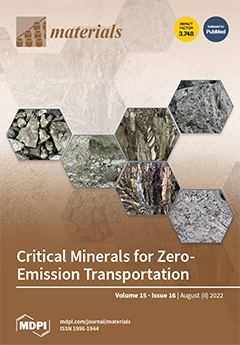The combination of cellulosic materials and metal oxide semiconductors can provide composites with superior functional properties compared to cellulose. By using nanocellulose derived from agricultural waste, we propose a one-pot and environmentally friendly approach to the synthesis of nanocellulose–TiO
2 (NC–TiO
2)
[...] Read more.
The combination of cellulosic materials and metal oxide semiconductors can provide composites with superior functional properties compared to cellulose. By using nanocellulose derived from agricultural waste, we propose a one-pot and environmentally friendly approach to the synthesis of nanocellulose–TiO
2 (NC–TiO
2) nanocomposites with peculiar photocatalytic activity and antibacterial effects. The as-prepared NC–TiO
2 composites were fully characterized by different techniques, such as X-ray diffraction (XRD), μ-Raman, Fourier transform infrared spectroscopy (FTIR), thermogravimetry analysis (TGA), scanning electron microscopy (SEM), transmission electron microscopy (TEM), and diffuse reflectance spectroscopy (DRS). The results showed that well crystalline anatase TiO
2 nanoparticles of about 5–6 nm were obtained. The photocatalytic activity in particular was evaluated by using methyl orange (MO) solution as a target pollutant at different pH values. It was found that all the tested NC–TiO
2 nanocomposites showed stable photocatalytic activity, even after consecutive photocatalytic runs. In addition, NCT nanocomposites with higher TiO
2 content showed degradation efficiency of almost 99% towards MO after 180 min of UV illumination. Finally, NC–TiO
2 nanocomposites also showed intriguing antimicrobial properties, demonstrating to be effective against Gram-positive (
Staphylococcus aureus,
Bacillus subtilis) with 20–25 mm of inhibition zone and Gram-negative bacteria (
Escherichia coli,
Pseudomonas aeuroginosa) with 21–24 mm of inhibition zone, and fungi (
Candida albicans) with 9–10 mm of inhibition zone.
Full article






